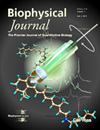Molecular Dynamics Simulations Reveal Subtle Consequences of H3 K9 and K27 Tri-Methylation.
IF 3.1
3区 生物学
Q2 BIOPHYSICS
引用次数: 0
Abstract
Epigenetic modifications of histone tails are key mechanisms of genome regulation. In particular, tri-methylation of Lysines (K) 9 and 27 of the histone H3 tail are important for genome silencing. In this work, we explore by all-atom molecular dynamics simulations the effect of these two epigenetic marks on the structure and interactions of the H3 tail in several contexts: isolated tails, nucleosomes, chromatosomes, and stacked nucleosomes. Overall, we find that although the isolated tails do not show significant conformational changes upon methylation, a more flexible and extended H3 tail compared to the native tail results in the nucleosome systems, with K9 methylation effects more profound. This change could facilitate the interaction of the tail with protein readers like HP1 or PcG. We also observe that both methylations increase the interactions of the H3 tail with the linker DNA in the context of the chromatosome, producing a chromatosome with tighter linker DNA, which could favor chromatin compaction. For stacked nucleosomes mimicking i±2 zigzag interactions, we see that methylation of either K9 or K27 reduces the interactions of one of the H3 tails with its parental nucleosome and increases its interactions with the non-parental nucleosome, which could also help compact the chromatin fiber. In the three nucleosome-containing systems, we observe an asymmetry between the two tails, especially in the chromatosome, where one tail extends to interact with the linker DNA. This asymmetry modulates the effect that methylation has on each tail. Thus, overall, methylations of K9 and K27 have a subtle but notable impact on the H3 tail structure and its interactions within the chromatin fiber. These results help explain how this epigenetic modification compacts chromatin fibers and promotes longer-range interactions; these changes also guide how to approximate these effects in coarse-grained chromatin models.分子动力学模拟揭示了h3k9和K27三甲基化的微妙后果。
组蛋白尾部的表观遗传修饰是基因组调控的关键机制。特别是,组蛋白H3尾部赖氨酸(K) 9和27的三甲基化对基因组沉默很重要。在这项工作中,我们通过全原子分子动力学模拟探索了这两个表观遗传标记在几种情况下对H3尾的结构和相互作用的影响:分离尾、核小体、染色体和堆叠核小体。总的来说,我们发现尽管分离的尾在甲基化时没有表现出明显的构象变化,但在核小体系统中,与天然尾相比,H3尾更灵活、更长,K9甲基化效应更深刻。这种变化可以促进尾部与HP1或PcG等蛋白质读取器的相互作用。我们还观察到,这两种甲基化都增加了H3尾部与连接体DNA在染色体背景下的相互作用,产生具有更紧密的连接体DNA的染色体,这可能有利于染色质压缩。对于模拟i±2之字形相互作用的堆叠核小体,我们发现K9或K27的甲基化减少了其中一条H3尾部与其亲本核小体的相互作用,并增加了其与非亲本核小体的相互作用,这也有助于染色质纤维的紧密化。在三个含核小体的系统中,我们观察到两条尾巴之间的不对称,特别是在染色体中,其中一条尾巴延伸到与连接体DNA相互作用。这种不对称调节了甲基化对每条尾巴的影响。因此,总的来说,K9和K27的甲基化对H3尾部结构及其在染色质纤维内的相互作用有微妙但显著的影响。这些结果有助于解释这种表观遗传修饰如何使染色质纤维致密并促进更远距离的相互作用;这些变化也指导了如何在粗粒度的染色质模型中近似这些影响。
本文章由计算机程序翻译,如有差异,请以英文原文为准。
求助全文
约1分钟内获得全文
求助全文
来源期刊

Biophysical journal
生物-生物物理
CiteScore
6.10
自引率
5.90%
发文量
3090
审稿时长
2 months
期刊介绍:
BJ publishes original articles, letters, and perspectives on important problems in modern biophysics. The papers should be written so as to be of interest to a broad community of biophysicists. BJ welcomes experimental studies that employ quantitative physical approaches for the study of biological systems, including or spanning scales from molecule to whole organism. Experimental studies of a purely descriptive or phenomenological nature, with no theoretical or mechanistic underpinning, are not appropriate for publication in BJ. Theoretical studies should offer new insights into the understanding ofexperimental results or suggest new experimentally testable hypotheses. Articles reporting significant methodological or technological advances, which have potential to open new areas of biophysical investigation, are also suitable for publication in BJ. Papers describing improvements in accuracy or speed of existing methods or extra detail within methods described previously are not suitable for BJ.
 求助内容:
求助内容: 应助结果提醒方式:
应助结果提醒方式:


